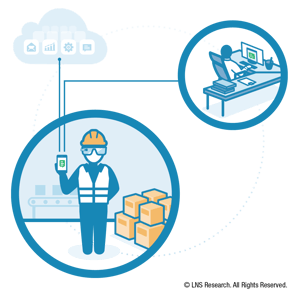On Wednesday, June 13, LNS Research co-presented the webcast, “The Connected Worker: Modernize Safety Risk Management” with Gensuite, a Cloud-based EHS management software provider. The presentation examined how safety and health leaders can use digital innovations to enable the connected worker, improve safety, and mitigate risk.
Q1: What are the key technology gaps impeding a fully realized connected worker environment?
 A1: A fully connected worker environment would involve the effective integration of many different systems, tools, and processes. It is a long-term ideal goal rather than one to be achieved in the short term. Key components of the connected worker environment include an Industrial Internet of Things (IIoT) platform and infrastructure, relevant backend applications and content repositories, mobile apps, and Edge hardware components such as sensor-equipped wearables, smart glasses, proximity beacons, and so forth. Inadequate network connectivity, disparate IoT platforms, lack of mobile devices provisioned with the right apps and insufficient back-end apps such as incident management, hazcom, audits, etc. are common technology gaps in the connected worker environment.
A1: A fully connected worker environment would involve the effective integration of many different systems, tools, and processes. It is a long-term ideal goal rather than one to be achieved in the short term. Key components of the connected worker environment include an Industrial Internet of Things (IIoT) platform and infrastructure, relevant backend applications and content repositories, mobile apps, and Edge hardware components such as sensor-equipped wearables, smart glasses, proximity beacons, and so forth. Inadequate network connectivity, disparate IoT platforms, lack of mobile devices provisioned with the right apps and insufficient back-end apps such as incident management, hazcom, audits, etc. are common technology gaps in the connected worker environment.
Q2: What is a typical roadmap for a company to apply Digital Transformation for health and safety?
A2: The roadmap is going to depend a lot on current capability maturity across people, process, and technology, and the overall readiness for change. There are typically three main technology adoption phases organizations go through in their EHS Digital Transformation journey. First is establishing a foundation by replacing spreadsheets and point solutions with Cloud-based enterprise software to manage data, workflows, and reporting. Next, extending those capabilities further into the enterprise with mobile applications that enable and engage more of the workforce. And, the third is enhancing mobile capabilities with advanced digital technologies, allowing the truly connected worker. The three steps don't need to be done sequentially, and not all are necessary in every case. The highest value will come from bringing these three aspects together with appropriate integration.
Q3: How do connected worker technology help reduce risk?
A3: It’s about using technology to increase interaction between the worker and the overall operational system within which they work. This includes providing more and better information access at the right time, the ability to collect, communicate, and analyze data from the work environment, thus enabling the worker to be more engaged and better informed in real time. Better bi-directional information flow supports better risk-based decisions at the work interface and throughout the organization. With more real-time visibility and insights, feedback loop cycle times are shortened, speeding up the continuous improvement (CI) process. It boils down to better information and insights for decision support and resource allocation. Connected workers can make better, faster decisions that improve safety and productivity, and benefit from more interaction with and automation of risk processes.
Q4: What advice do you have for getting started with digital technologies for health and safety?
A4: The critical piece of advice is to think big but start small. Identify a specific pain point and the business impact of that problem. Use that as the starting point, implement, show results and use that to expand the initiative. Connected worker projects can be relatively low cost and deliver value quickly. For example, use of smart glasses to deliver safe work instructions and hazcom information at the point of work could be a quick win. Another recommendation is to latch onto the organization’s key initiatives and show how your project supports them. This could mean engaging with the Operational Excellence and/or Digital Transformation efforts.
Q5: How do you recommend convincing a company to implement connected worker technology?
A5: Companies make investment decisions based on business cases, so showing the ROI and business value with a compelling business case is essential. Unless your part of the business already has funding available, you’re going to compete against other projects and will need to differentiate. The starting point is to pick the right battle. Identify a specific business problem to be addressed that is also feasible to solve. Even a strong business case might fail without a key ingredient: stakeholder alignment. Your initiative will impact various parts of the organization. Identify key stakeholders who have something to lose or gain and build support with them for the business case in advance. Show them “What’s in it for me?,” and how any risks will be managed. Know who the decision-makers and influencers are, and how the decision will be made. Pre-selling the business case will help, to the point where you are confident of approval before you submit it.